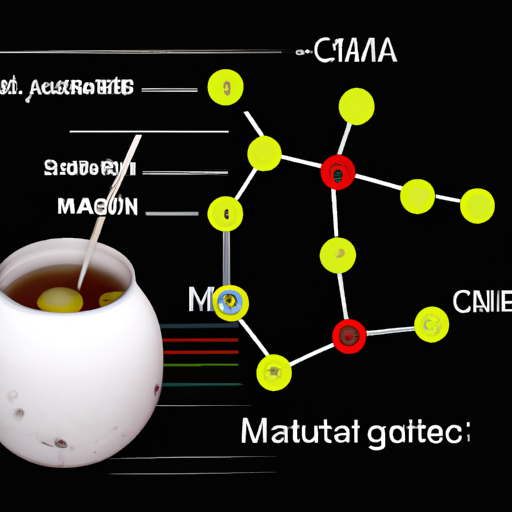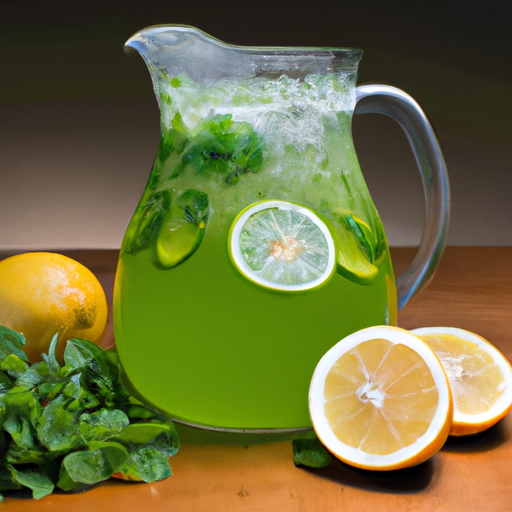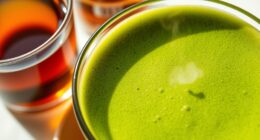I’ve always had a strong appreciation for matcha, the finely milled green tea powder that hails from Japan. It’s not just loaded with antioxidants and essential nutrients; its distinct taste also lends itself to an endless variety of recipes.
One of my favorite ways to enjoy matcha is by making iced matcha, which is perfect for hot summer days or as a refreshing pick-me-up any time of year.
In this article, I will share with you my tips and tricks on how to make the perfect iced matcha at home. From selecting the right type of matcha powder to preparing the tea and making the perfect ice cubes, I’ll cover everything you need to know to create a delicious and healthy drink that will impress your friends and family.
So grab your equipment and ingredients, let’s get started!
Key Takeaways
- Choosing high-quality and organic matcha powder is crucial for a delicious and healthy iced matcha.
- Proper equipment and technique, such as using a bamboo whisk, can help achieve the perfect consistency and frothiness.
- Adding creative ice shapes and garnishes can enhance both the presentation and flavor of the drink.
- Regularly drinking iced matcha can provide numerous health benefits, such as increased energy and improved focus.
What is Matcha and Why It’s Good for You
If you’re looking for a healthy and delicious way to start your day, you should try drinking matcha. This vibrant green tea powder is packed with antioxidants, which are essential for keeping our bodies healthy.
Matcha comes from the same plant as regular green tea, but it’s grown differently and has a unique taste profile. Matcha has a long history that dates back to ancient Chinese culture. Over time, it became an important part of Japanese tea ceremonies and was used in Buddhist monasteries to help monks stay alert during meditation.
Today, matcha is enjoyed all over the world for its health benefits and refreshing flavor. Matcha cultivation involves shading the tea plants from sunlight several weeks before harvest. This process increases the chlorophyll content in the leaves and gives them their bright green color.
After harvesting, the leaves are steamed and dried before being ground into a fine powder. The result is a delicate tea with a smooth texture that can be used in many different recipes, including iced matcha lattes!
To make the perfect iced matcha latte, it’s important to select the right type of matcha powder. With so many options available on the market today, it can be overwhelming to choose one that will give you the best results. But don’t worry – I’ll show you how to pick out high-quality matcha powder in my next section.
Selecting the Right Type of Matcha Powder
When it comes to selecting the right type of matcha powder, there are a few key points to consider. First and foremost, understanding the grades of matcha powder is essential in determining the quality and taste you can expect.
Additionally, choosing organic and high-quality matcha will ensure that you’re getting a pure product with all its health benefits intact. As someone who loves matcha, I always make sure to do my research before making a purchase to ensure I’m getting the best possible product for my body.
Grades of matcha powder
Wow, the difference in quality between low-grade and high-grade matcha powder is like night and day! Different grades of matcha powder are based on several factors such as the location of tea plants, time of harvest, processing methods, and quality control.
Each grade has its own unique taste profile that ranges from grassy and bitter to sweet and smooth. Low-grade matcha powder is typically harvested from older tea leaves that have a harsher taste due to their lower concentration of amino acids. These leaves are also often processed with machines which can decrease their flavor complexity.
On the other hand, high-grade matcha powder comes from younger tea leaves that are shade-grown for several weeks prior to being harvested by hand. This results in a higher concentration of amino acids which lends itself to a smoother texture and sweeter tasting notes.
When choosing organic and high-quality matcha, it’s important to consider both the grade of the powder as well as where it comes from. Look for reputable brands that adhere to strict standards when sourcing their tea leaves. By selecting premium quality matcha powder, you’ll be able to fully appreciate its delicate flavors and health benefits without any bitterness or grittiness.
Choosing organic and high-quality matcha
To truly savor the delicate and smooth flavors of matcha, it’s essential to choose organic and high-quality powder sourced from reputable brands. Here are some reasons why:
-
Organic certification ensures that the matcha is free from harmful pesticides, herbicides, or other synthetic chemicals.
-
Sourcing options matter – look for matcha that comes from Japan, where the tea bushes are shaded prior to harvest, resulting in a more vibrant green color and richer taste.
-
High quality matcha will have a fine, powdery texture and a fresh aroma.
-
When purchasing matcha powder, check the packaging date as freshness makes a significant difference in taste.
With these factors in mind, you can elevate your iced matcha experience by choosing an organic and high-quality powder that will provide you with a deliciously smooth and flavorful drink.
Now let’s move on to essential equipment and ingredients for preparing this refreshing beverage!
Essential Equipment and Ingredients
You’ll need a few key items to make delicious iced matcha at home. First and foremost, you’ll need high-quality matcha powder. It’s important to choose organic and high-quality matcha for the best taste. You don’t want to skimp on this ingredient since it’s the star of the show!
In addition to matcha powder, you’ll also need a whisk and a bowl. The whisk is essential for properly mixing the matcha powder with water or milk. A traditional bamboo whisk works best, but you can also use an electric frother if you prefer.
As for the bowl, any medium-sized bowl will do. Once you have your essential equipment and ingredients ready, it’s time to prepare your iced matcha! But before we dive into that, let me share some tips on how to get the most out of your matcha powder…
How to Prepare the Tea
When preparing matcha tea, there are a few key steps to follow in order to achieve the perfect balance of flavor and texture.
First, I measure out the right amount of matcha powder and water to ensure that the ratio is just right.
Then, I use a bamboo whisk to froth up the tea until it has a smooth and velvety consistency.
Finally, I taste the tea and adjust any flavors as needed before enjoying my delicious cup of matcha.
Measuring the powder and water
First, grab your measuring spoon and scoop out the perfect amount of matcha powder. Then, add it to your glass or shaker along with a splash of hot water. Measuring accuracy is key in achieving the perfect cup of iced matcha, so be sure to measure carefully.
A general rule for measuring matcha powder is 1 teaspoon per 8 ounces of water.
Next, pour in cold water until the glass or shaker is about halfway full. Adjusting consistency at this point is important to ensure that the final product isn’t too thick or too thin. If you prefer a thicker consistency, use less water than recommended. For a thinner consistency, add more water as needed.
With these steps complete, it’s time to move on to whisking the tea into its frothy goodness!
Whisking the tea
To get that perfectly frothy matcha, start whisking vigorously until your arm feels like it’s about to fall off! The key to achieving that frothy texture in your iced matcha is all in the proper whisking technique.
You want to use a bamboo whisk and make quick back-and-forth motions while keeping the tip of the whisk at the bottom of the cup. It’s important not to press too hard or move too slowly, as this will result in clumps and an uneven texture.
As you continue to whisk, you’ll notice that the color of the matcha will change from a bright green to a more muted shade. This is normal and indicates that you’re on track! Keep whisking for at least 30 seconds or until there are no clumps left and a thick layer of foam has formed on top.
Once you’ve achieved that perfect froth, it’s time to move onto adjusting the taste by adding sweeteners or other flavors.
Adjusting the taste
After whisking the tea, it’s time to adjust the taste of your iced matcha. This step is important because it allows you to customize your beverage based on your personal preferences. You can add sweeteners or flavorings to make it as sweet or as flavorful as you like. Personally, I prefer my matcha with a touch of honey and vanilla extract.
To help you decide which sweetener or flavoring works best for you, I’ve created a table below that outlines some common options along with their pros and cons:
| Sweetener/Flavoring | Pros | Cons |
|---|---|---|
| Honey | Natural sweetness; adds depth to flavor | Can be overpowering if too much is added |
| Agave nectar | Low glycemic index; mild taste | Can be too thin in consistency |
| Maple syrup | Adds natural sweetness; rich flavor profile | Can overpower the matcha if too much is used |
| Vanilla extract/paste/powder | Adds depth and complexity to the flavor profile; complements other flavors well | Too much can make the drink taste artificial |
Once you have chosen your preferred sweetener or flavoring, simply stir it into your whisked matcha until fully incorporated. And now that we’ve adjusted our iced matcha to our liking, let’s move on to making the perfect ice cubes!
Making the Perfect Ice Cubes
Now, you’re probably wondering how to make the perfect ice cubes for your iced matcha. In order to achieve the ideal texture and temperature, it’s important to consider two factors: creative ice shapes and perfect melting time.
For instance, if you want your matcha to be colder for a longer period of time without watering it down too much, try making larger ice cubes or even spheres. These will take longer to melt and keep your drink refreshing until the very last sip.
Another way to add some excitement to your iced matcha is by using flavored ice cubes for added flavor. You can infuse water with fruits such as lemon or berries before freezing them in trays or molds. This will give a subtle taste upgrade without overpowering the delicate flavor of matcha.
Alternatively, you can use coconut water instead of regular water for a tropical twist that complements the earthy notes of green tea perfectly.
Once you’ve got your ice cubes ready, it’s time to assemble your iced matcha! Remember that there are no hard rules when it comes down to making this beverage – feel free to experiment with different ratios of milk, sweeteners or garnishes until you find what works best for you.
So grab your favorite glass and start creating your own version of this delicious summer drink!
Assembling Your Iced Matcha
Get ready to experience a refreshing and energizing summer treat with your very own personalized blend of creamy milk, sweeteners, and garnishes mixed together with the earthy notes of green tea in a cool glass. Assembling your iced matcha is easy, but there are some important steps you should take to ensure that your drink comes out perfectly every time.
First, grab your ice cube trays and fill them up with water. Freeze the trays overnight so that you have plenty of ice cubes on hand when it’s time to make your drink.
Next, gather all of your ingredients including matcha powder, milk or plant-based alternatives like almond or soy milk, sweeteners such as honey or agave nectar, and any additional garnishes like mint leaves or sliced fruit.
Now it’s time to assemble! The process is simple: just combine one teaspoon of matcha powder with one cup of milk in a blender. Add in any desired sweeteners and blend until everything is smooth and well combined.
Pour the mixture over a tall glass filled halfway with ice cubes. Finally, add any additional garnishes you like and give everything a quick stir before enjoying your delicious iced matcha creation!
Assembling your iced matcha can be fun and easy once you have all the necessary ingredients ready to go. However, if you’re feeling adventurous, there are many different variations of this drink that you can try out for yourself! From adding vanilla extract to switching up the type of sweetener used – the possibilities are endless when it comes to making this delicious beverage at home. So why not experiment today?
Variations of Iced Matcha
When it comes to iced matcha, there are a variety of ways to switch things up and add some excitement. Personally, I love adding fresh fruit or herbs like mint or basil to my drink for an extra burst of flavor.
Another great option is making a matcha latte by adding milk or a milk alternative for a creamy twist on the traditional drink. These variations can take your iced matcha game to the next level and make for a refreshing treat on a hot day.
Adding fruit or herbs
To elevate the flavor profile of your iced matcha, try incorporating some fresh fruit or herbs into the mix. Fruit infused matcha is a great way to add some sweetness and tanginess to your drink.
Some popular fruits to use include strawberries, blueberries, and mangoes. Simply blend the fruit with your matcha powder and milk for a refreshing and flavorful beverage.
Herbal matcha blends are another great option for adding depth to your iced matcha. Mint, lavender, and rosemary are just a few examples of herbs that can complement the earthy notes of matcha.
These blends can be made by mixing dried herbs with your matcha powder before whisking in hot water or milk. The resulting drink is not only delicious but also has added health benefits from the herbal infusion.
Now let’s move on to making a matcha latte using these same ingredients!
Making a matcha latte
First, froth your milk with a handheld frother or in a blender to create a creamy consistency for your marvelous matcha latte. I prefer using almond milk as it adds a subtle nutty flavor that complements the earthiness of the matcha. However, you can also use other milk alternatives such as oat, soy, or coconut milk depending on your preference.
Once you’ve frothed your milk, add it to a cup containing 1-2 teaspoons of matcha powder and stir until fully combined. For flavor variations, you can add honey or vanilla extract to sweeten up your drink or sprinkle some cinnamon on top for an extra kick.
Now sit back, relax and enjoy this deliciously satisfying matcha latte! As for storing and serving tips…
Storing and Serving Tips
Additionally, if you want to impress your guests with a beautiful presentation, you can serve the iced matcha in a clear glass with ice cubes and a slice of lemon or lime. This not only adds aesthetic appeal but also enhances the flavor of the matcha.
When storing matcha, it’s important to keep it in an air-tight container away from direct sunlight or heat. Matcha is highly sensitive to light and heat, which can cause oxidation and spoil its taste.
As for serving suggestions, iced matcha is best enjoyed on a hot summer day as a refreshing drink that provides energy and focus without the jittery feeling of coffee. It pairs well with light snacks such as fruit salad or sushi rolls. For an extra indulgence, try adding coconut milk or almond milk instead of regular milk for a creamy texture.
Proper storage and serving techniques are crucial in bringing out the best qualities of iced matcha. By following these tips, you can ensure that your guests will enjoy a flavorful and visually pleasing experience.
Up next, we’ll talk about the benefits of drinking iced matcha for both physical health and mental wellness.
Benefits of Drinking Iced Matcha
Drinking iced matcha can provide a range of health benefits, thanks to its high antioxidant content. This Japanese green tea contains natural compounds called catechins that help protect cells from damage caused by free radicals.
Matcha also has the potential to boost metabolism and support weight loss efforts. In fact, some studies suggest that drinking matcha regularly may even help reduce the risk of chronic diseases like heart disease and cancer.
In addition to its antioxidant properties, iced matcha can offer hydration benefits as well. Unlike other caffeinated beverages like coffee or black tea, matcha is relatively low in caffeine but high in L-theanine, an amino acid that promotes relaxation and focus.
This unique combination can help improve mental clarity and increase energy levels without causing jitters or anxiety. Plus, when consumed as iced matcha latte with milk or a non-dairy alternative, the drink provides a refreshing way to hydrate during hot weather.
Overall, if you’re looking for a delicious way to support your physical and mental wellbeing while staying hydrated this summer, consider giving iced matcha a try! With its numerous health benefits and versatile flavor profile (it pairs well with everything from almond milk to lemonade), it’s no wonder this trendy beverage has become so popular in recent years. Just be sure to choose high-quality ceremonial grade matcha powder for best results!
Frequently Asked Questions
Can I use regular green tea powder instead of matcha powder?
Yes, you can’t use regular green tea powder as a substitute for matcha powder. Matcha powder is made from shade-grown tea leaves that are ground into a fine powder, while green tea powder is simply powdered green tea leaves. The differences in production result in differences in flavor, texture, and nutritional content.
Matcha has a stronger, more complex flavor than regular green tea and contains higher levels of antioxidants and caffeine. When choosing a matcha powder for your iced matcha, look for high-quality ceremonial grade matcha that is bright green in color with a smooth texture. Avoid culinary grade matcha or anything labeled ‘matcha-flavored’ as they may contain added sugars or artificial flavors that can compromise the taste and health benefits of your drink.
How long can I store matcha powder and how should I store it?
As a matcha enthusiast, I’ve learned that proper storage is crucial for maintaining the quality and flavor of your powder.
To answer the question at hand, matcha powder can last up to a year if stored correctly. The key is to keep it in an airtight container away from sunlight, heat, and moisture.
It’s also essential to avoid storing it in the fridge or freezer as this can cause condensation and compromise its delicate taste.
When looking for storage tips for matcha powder, remember to keep it cool, dry, and sealed tightly. By following these simple steps, you’ll be able to enjoy fresh-tasting matcha whenever you’re ready to whip up your favorite drink or recipe!
Can I add sweeteners like sugar or honey to my iced matcha?
Yes, you can definitely add alternative sweeteners like sugar or honey to your iced matcha. However, it’s important to note that traditional matcha is already naturally sweet and has a unique umami flavor.
When mixing in sweeteners, it’s recommended to start with a small amount and adjust according to taste preference. Mixing techniques are also important – make sure the sweetener is well dissolved before adding ice and cold water for a smooth and consistent taste.
Experimenting with different alternative sweeteners such as agave nectar or stevia can also enhance the flavor of your iced matcha without overpowering its natural taste.
Can I use almond milk or other non-dairy milk alternatives in my iced matcha?
Non-dairy milk alternatives are a great addition to my iced matcha recipe. Personally, I prefer almond milk for its nutty and creamy flavor that complements the earthy tones of matcha tea. However, there are many other options available, such as soy milk, coconut milk, or oat milk, which can add a unique twist to the drink.
Non-dairy milks also have the added bonus of being lactose-free and vegan-friendly. When experimenting with flavors, consider adding vanilla extract or coconut cream for a sweet taste, or cinnamon and nutmeg for a spicy kick. The possibilities are endless!
Can I make a large batch of iced matcha and store it in the fridge for later consumption?
Yes, I’ve made a large batch of iced matcha before and stored it in the fridge for later consumption.
When making a large batch, I recommend using a container that has an airtight seal to keep the matcha fresh. It’s important to let the matcha cool down to room temperature before storing it in the fridge, as putting hot liquids in the fridge can cause bacteria growth.
Additionally, be sure to stir or shake the container well before pouring a glass of iced matcha as some settling may occur during storage.
As for storage options, I’d suggest consuming the iced matcha within 24-48 hours for optimal freshness.
Conclusion
In conclusion, making iced matcha is a refreshing and healthy way to cool down on a hot day. The process may seem intimidating at first, but with the right equipment and ingredients, anyone can create a delicious cup of this antioxidant-packed tea.
From selecting the right type of matcha powder to making the perfect ice cubes, I’ve shared all my tips for creating the perfect iced matcha. So next time you’re feeling parched in the summer heat, skip the sugary drinks and give iced matcha a try. Trust me, it’s worth it!
The creamy texture combined with the earthy flavor will transport you to a zen-like state that no other drink can accomplish. So go ahead and indulge in this hyperbole-worthy beverage that’s both healthy and delicious.










